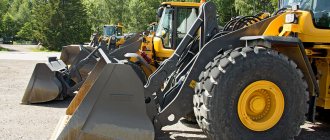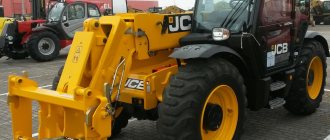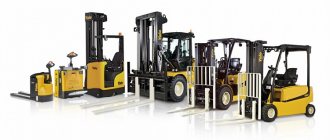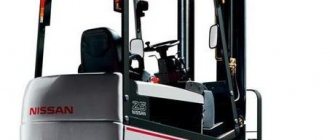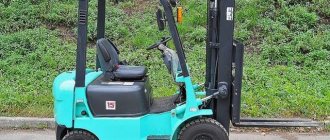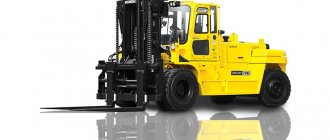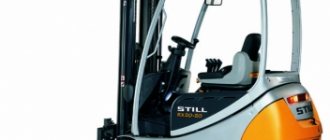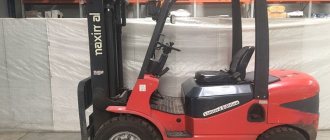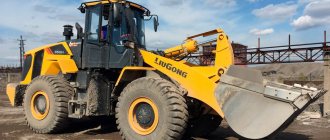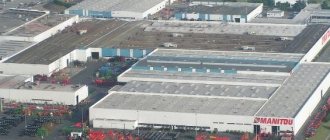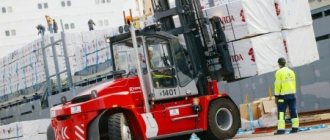Technology is one of the main elements without which the operation of a warehouse is impossible. The variety of types of warehouse equipment allows us to service warehouses of any size and facilitates the process of performing all work. In particular, warehouse forklifts are a prerequisite for the normal functioning of the premises.
Loading equipment is a type of special equipment that is used to lift, lower and transport cargo throughout the warehouse.
There are more than a dozen types of forklifts depending on their technical and functional features. For example, depending on the type of cargo handling, forklifts and bucket loaders are distinguished. As is clear from the names, the main working tool of the first is a fork, the second is a ladle.
In addition, loading equipment differs in the type of drive: there are forklifts that run on gasoline, gas or diesel, and electric forklifts that are charged from the mains. Forklifts have different tires - pneumatic for uneven surfaces and solid for smooth floors. The lifting device can be located either at the front or at the side. The carrying capacity and dimensions of special equipment can also vary greatly.
It's easy to get confused in such diversity. To prevent this from happening, when purchasing warehouse loading equipment, pay attention to the parameters of the room in which it will be used. In addition to the characteristics of the warehouse, when choosing such special equipment, you should also pay attention to the characteristics of the cargo that you will be working with.
To make your decision easier, answer the following questions:
- In what container is the cargo that needs to be reloaded? These can be pallets, containers, barrels, etc.
- How far does the cargo need to be transported?
- What should be the maximum lifting capacity of the equipment?
- How many hours a day will the equipment work?
- Where will the equipment be used? Outdoors, indoors?
- Are the dimensions of the equipment suitable for the size and infrastructure of your warehouse?
- What specific tasks should the forklift perform and in what order?
Classification of forklifts by warehouse type
Different types of forklifts are suitable for different warehouses and the work planned there. The following factors influence the choice of loader:
- Where is the warehouse located - outdoors or indoors?
Electric forklifts are more suitable for working in confined spaces. For outdoor use, the best option is diesel or gasoline. This is due to the fact that the engines of forklifts emit harmful gases during operation, which are not ventilated indoors and can become a threat to the lives of employees.
- floor surface
To work on uneven floor surfaces, forklifts with pneumatic tires are chosen. Solid tires are the ideal choice for flat floors and are very durable.
- distance between racks
If the aisles between the rows are narrow, pay attention to stackers - this is one of the types of lifting equipment. The stacker is more compact than a forklift and therefore will go where a forklift cannot. However, because of this, the height and volume of the loads lifted are less.
- shelving height
To choose the appropriate forklift model, determine the highest point in the warehouse where you will need to transport and lift the load and add another five meters to this - it is better to take it with a small margin.
- maximum cargo weight and dimensions
Loaders have different load capacities. The principle here is the same as with height - calculate the maximum weight of the cargo that you plan to move and add a few more kilograms or hundreds of kilograms to it if the cargo in the warehouse is heavy.
- what kind of cargo will be transported
When choosing a loader drive - electric, gasoline, gas or diesel, consider what products are stored in the warehouse. If we are talking about food products without sealed containers, medicines or children's products, then models running on diesel or gasoline are not suitable. Many people neglect this rule, making a serious mistake.
If contact with flammable goods is expected, the forklift must be equipped with a fire protection system.
- work intensity
If the forklift will be used frequently, study its maneuverability - minimum turning radius, travel dimensions (with and without a load), speed of movement, lifting and lowering loads, battery capacity or fuel consumption.
dimensions
The overall dimensions, which include height, width, and length with and without forks, determine the machine’s ability to function in areas with limited space.
The overall height with the mast folded means the distance from the traveling surface to the top or other highest part of the loader when the forklift is folded, as well as when the fork carriage is in the lower position.
Dimensions affect another important parameter - maneuverability. This technical characteristic, which guarantees the safe operation of the machine in rooms with different configurations, depends on the turning radius and the minimum passage width required to move the loader in equipped condition. According to the specifications, the turning radius and cargo dimensions must comply with the minimum width of passages in warehouses.
Technical characteristics of various forklifts
Depending on their functional properties, loaders are divided into different types. The most commonly encountered and used classification is ITA - the American Industrial Transport Association. Not all types of equipment listed there are suitable for use in warehouses. We will only consider those that are suitable for working in a warehouse.
| Loader type | Advantages | Flaws |
| Electric forklifts with counterbalance | Quiet; no exhaust gases are emitted | The battery needs to be recharged; It is better not to use for outdoor work |
| Narrow aisle loaders | Allows you to increase the usable area of the warehouse by moving the racks closer | Expensive, difficult to use |
| Self-propelled electric trolleys and electric stackers | Easy to use, inexpensive | Low power and load capacity |
| Forklifts with solid tires | Ideal for use on flat surfaces | Low ground clearance does not allow driving on the street if the road there is uneven |
| Forklift trucks with tubed pneumatic tires | Universal, fast, in addition to pallets, can move containers | Large dimensions and exhaust gases do not allow them to be used inside a warehouse for a long time |
Electric forklifts with counterbalance
They operate from a rechargeable battery – it also serves as a counterweight. Since this type of forklift does not use fuel during operation, it does not emit exhaust gases, does not heat up and does not make noise. All this makes them the most suitable option for working indoors, with food products, children's products, and medicines. They are not very suitable for working outdoors.
Narrow aisle loaders
A distinctive feature of these machines is their small size and great maneuverability. Using narrow aisle loading machines, you can increase the usable warehouse area - reducing the distance between racks as much as possible. Their disadvantage is that they are more expensive than larger equipment and more difficult to operate.
Self-propelled electric trolleys, electric stackers
Electric trolleys and electric stackers are also suitable for working inside warehouses due to the absence of harmful emissions. They are inexpensive and easy to use. Their disadvantage is the small height to which they can lift a load (no more than 2 meters) and their small carrying capacity.
Forklifts with solid tires
Unlike the forklifts described above, forklifts are powered by an internal combustion engine. If the engine is gas, then such equipment can operate in ventilated areas. Solid tires are designed for use on flat, hard surfaces - they are most effective on smooth floors and are not afraid of punctures.
Forklifts with pneumatic tires
This category of machines is intended for use outdoors or inside large ventilated warehouses due to the presence of an internal combustion engine. Due to their high power, such forklifts can lift not only pallets, but also containers. In addition, pneumatic tires are suitable for use on uneven surfaces.
Currently, the most popular and convenient for working in a warehouse are forklifts with various types of engines and tires.
Efficiency and human factor
When choosing special warehouse equipment, it is important to take into account the human factor, as well as the conditions under which it can be minimized:
- A comfortable machine makes the operator more productive by preventing accidents and reducing fatigue.
- A safe machine enables the operator to take maximum advantage of productivity.
- The ability to maneuver in tight spaces allows for maximum use of warehouse space. The result is maximum storage density.
- A prerequisite for maneuverability is excellent visibility. It gives the operator the opportunity to accurately assess the dimensions of special equipment and work safely in cramped conditions.
- The reliability of the equipment is influenced by the design and build quality. Together, these factors ensure uninterrupted operation of the equipment.
Features of using a forklift
When choosing a loader, pay attention to the following characteristics:
- how heavy the load can be withstood by the forks (average load capacity is from 1.5 to 8.5 tons);
- how high the load rises - from 1.5 to 30 m;
- engine power - on average 48-62 hp;
- how many degrees the forklift can tilt – from 3 to 12.
The functionality of the machine can be greatly expanded if you use replaceable equipment - various attachments:
- pincer gripper - used for working with lumber and forests;
- pin gripper – for moving ring-shaped loads. For example, when transporting pipes, the pin is pushed inside the ring;
- ladle – for crumbly materials (if they are light enough);
- grip in the form of a crane - convenient for working with loads that are inconvenient to grab with forks;
- as well as a large number of special-purpose grips for handling a wide variety of loads - there are even fork extensions and an attachment for turning the loader into a snow blower.
Vehicle type code 57001
Loader (not auto-) belongs to code 57001 “Other self-propelled vehicles, pneumatic and tracked machines and mechanisms.”
This code includes:
- mobile lifting and transport equipment (in particular, general purpose cranes on pneumatic wheels, trucks and caterpillar tracks);
- other self-propelled machines and equipment (in particular, excavators, bulldozers, self-propelled scrapers and graders, ditch diggers and sewer cleaners, land reclamation machines, road construction machines, snow blowers, road rollers);
- machines for transporting drilling equipment (equipment for transporting drill pipes, complexes for transporting drilling equipment);
- other self-propelled machines and mechanisms on pneumatic and tracked tracks, included in other groups.
Selection of personnel to service loading equipment
Maintenance of loading equipment is the responsibility of the forklift driver. This is an employee who operates a forklift, unloads or loads, secures it on the vehicle, and is also responsible for the integrity of the cargo and the technical condition of the vehicle.
Operating a forklift is a complex and responsible task. In addition to driving, the driver must carry out mandatory control inspections of equipment at the beginning and end of the working day, and engage in repairs and maintenance.
When selecting personnel to work with loading equipment, make sure that candidates:
- are familiar with the functional properties of special equipment and mechanisms and their structure;
- know how to lift, load, unload and move cargo using forklifts;
- know and adhere to the rules of the road, including the rules for moving around the warehouse and surrounding areas;
- understand the rules of working with acids, alkalis, flammable and lubricants;
- follow safety rules when working on loading equipment.
To ensure that a forklift driver candidate has these skills, check to see if they have a license that allows them to operate a specific type of forklift. For the driver of an electric forklift, a certificate issued by a specialized educational institution - an electric forklift driver's license - is sufficient.
To work on loaders with high power (more than 4 kW) or those powered by gas, gasoline or diesel, an employee must have a driver’s license as a tractor driver.
Also, all drivers of electric pallet trucks, stackers and forklifts must have medical certificates.
In addition to documents and technical training, the forklift operator must have the following qualities:
- good eye and hearing;
- fast reaction;
- attentiveness and accuracy;
- patience to endure repetitive work;
- good coordination;
- stress resistance;
- physical endurance;
- responsibility.
Narrow aisle stacker (narrow aisle)
The special design of these machines allows you to work in a narrow interrack space while moving in a straight line. The special design allows the forks to be rotated 90 degrees in both directions. Compared to a conventional reach truck, it allows you to make the aisles between racks 50% smaller. The lifting height of such stackers reaches 12 m. There are configurations with both internal combustion engines and electric motors. Most often, such stackers are used in large warehouses if the goal is to increase the usable storage area. Advantages:
- saving warehouse space.
Let's sum it up
Loaders are a type of special equipment that is designed to move goods and work related to their loading and unloading. Loading machines differ from each other in purpose, maneuverability, engine type, gripping mechanism and load capacity. The most convenient for working in a warehouse is a forklift, but it is also divided into several types. In order to choose the appropriate equipment, study the features of the warehouse and the goods that will need to be transported. Operating a forklift is a complex process that can only be handled by a specially trained person. When choosing a forklift driver, make sure that he has all the necessary knowledge and skills not only to operate, but also to care for the equipment. Read about other warehouse equipment in our blog.
A vehicle type code for a forklift that has long been considered controversial
Discussions about what code should be assigned to a forklift continued for several years. According to the latest opinion, which is taken into account when filling out the declaration, a forklift can be classified as other vehicles with code 590 00. This is justified by the fact that forklifts are not vehicles that are grouped into a separate subsection “Vehicles” (code 15 0000000) in OKOF codes. In the directory OK 013-94B they are included in the subsection “Machinery and Equipment” (code 14 0000000) OKOF under code 14 2915540.
Therefore, as a vehicle type code for tax purposes for a forklift, you can select code 590 00 “Other vehicles”. There is still no official position of officials on this issue.
Optional equipment
Let us note several types of the most commonly used additional equipment that is installed on forklifts.
- Active stability system or SAS (System of Active Stability). Installed as additional rollover protection. If the permissible speed and turning radius parameters are exceeded, it blocks the steering and does not allow it to accelerate faster than the speed when the centrifugal force grows to critical values and becomes capable of overturning the car.
- Operator presence sensor. Also a security system. Installed in the driver's seat. Disables the ability to lift the forks and move the machine if the operator leaves the cab.
- Safety light. It illuminates the movement path several meters in front of the loader with a clearly visible, bright beam of light. Warns others when the forklift is moving around a corner or when leaving a building.
- Additional interior heater. Installed in forklifts with a closed cabin operating in northern regions.
- Non-standard lifting equipment. Typically, attachments for handling non-standard loads are ordered from the forklift manufacturer or supplier. Moreover, the range of various traverses, pincers, grippers and other types of equipment includes dozens of items and is only expanding every year.
Vehicles not included in the ITA classification
To handle long loads, two types of warehouse loaders are used: side-mounted and multi-pass. The first type of machine has platforms on the sides of the forks that help stabilize the loads. Multi-pass forklifts are compact and move from a standstill in any direction.
To handle long loads (pipes, siding, timber, rolled steel, etc.), two types of warehouse loaders are used: side and multi-pass. These machines are capable of working in narrow passages and openings, which is why they are often classified as Class II. However, this is only true for electric models. If they are equipped with internal combustion engines, then they belong to forklifts (classes IV, V).
Side loaders have retractable forks located on the side. On the sides of the forklift there are platforms that serve to support the load during transportation. These machines have the following features:
- To pick up an item from a shelf or stack, they do not need to turn their front to it - they simply move along the rack.
- Long loads are transported sideways, which is very convenient.
- Supporting platforms ensure safe transport.
- The transported loads do not obscure the operator's view from the front and rear.
Multi-pass loaders are also equipped with retractable forks, but are more compact and move away in any direction. They are maneuverable and move with high precision, which makes them popular in cluttered warehouses.
Return to the list of articles You have successfully logged in to the site Thank you for registering. Go to Personal Account
How to choose the right manufacturer?
Take another look at the impressive list of companies above. What to choose: Caterpillar or Toyota? STILL or Hyndai? And if it is decided that it is necessary to buy from the Chinese, then from whom exactly?
It is very difficult to rely on the subjectivity of supply managers - everyone will try to sell you the equipment that they are personally interested in selling, and what exactly this interest is based on is anyone’s guess. How to figure it out on your own?
To find the right answer to this question, analyze the specifics of your enterprise, talk with colleagues working in similar conditions, and ask for their recommendations.
Next, one of the significant indicators is the “length of the loader line” for each company. For example, CVS Ferrari (Italy) has 14 forklifts, and Clark (USA) has about 60. The leaders in this indicator are Mitsubishi (Japan), Linde (Germany) and Heli (China) (about 100 types of forklifts). loaders each), Hundai Heavy Industries Ltd. (more than 130) and Komatsu (about 150).
Of course, significant factors when choosing equipment are the period of continuous operation, warranty conditions, availability and price of consumables, and other operating costs must be taken into account.
Electric stacker (Electric stacker)
An electric stacker essentially not only performs the functionality of an electric trolley for moving cargo, but is also equipped with a mast, which allows it to lift palletized loads to a significant height of up to 6 m. Electric stackers are equipped with an electric motor and a traction battery. An electric stacker is an indispensable assistant in any modern warehouse with high racks. Main advantages:
- high speed of cargo processing;
- simple controls;
- ability to work in confined spaces.
News from the market
The volume of supply is frightening: equipment of all types and purposes, manufacturers and configurations...
Having conducted a simple marketing research using the “Query Statistics” option in Yandex, we were able to compile a preference rating (from the most popular to the least requested) - what types of warehouse equipment are interested in people responsible for the smooth operation of the warehouse.
Here are the results:
- front loader (the leader with a huge gap from its pursuers);
- forklift;
- stacker;
- electric forklift;
- mini loader;
- hydraulic trolley;
- telescopic loader;
- reach truck;
- lifting table;
- electric trolley;
- reachstacker.
However, we made a strong-willed decision to put the leader aside - since its functions are much broader (it can be used not only for capturing, loading and transporting various materials, but also for performing quarry and earth-moving work) - and stop at considering such purely warehouse equipment as forklift.
